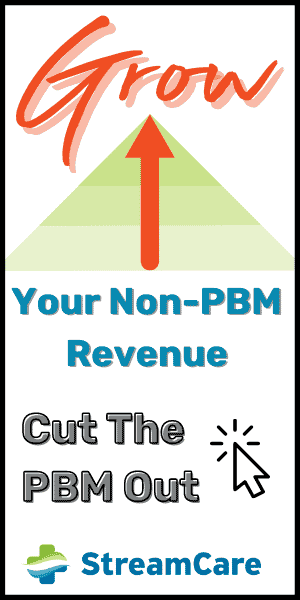While DSCSA (the Drug Supply Chain Security Act) enforcement is postponed until November 2024, it is critical to move forward in becoming compliant sooner rather than later.
In the world of running a pharmacy, patient safety is Everything. To achieve this, the U.S. pharmaceutical industry is wrapped up in a web of regulations, and one of the most significant in recent years is the Drug Supply Chain Security Act (DSCSA).
For pharmacy owners, it’s not just a legal requirement; it’s a required step in ensuring the safety of the drug supply chain.
Exploring the Drug Supply Chain Security Act (DSCSA)
The DSCSA, signed into law in 2013, aims to heighten the security of the pharmaceutical supply chain by creating a framework for traceability and accountability. Its main goals are:
1. Counterfeit Drug Prevention
The DSCSA aims to minimize the risk of counterfeit drugs entering the legitimate pharmaceutical supply chain. Counterfeit drugs are fake or substandard medications that can harm patients and undermine trust in the healthcare system. If you think that doesn’t happen nowadays, here’s an article about recent counterfeit HIV medications.
To achieve this, the DSCSA mandates the implementation of systems and processes that improve the traceability and accountability of pharmaceutical products throughout their journey from the manufacturer to the patient. This tracking involves the use of unique product identifiers, such as serial numbers and barcodes, on drug packaging to track their movement.
By enhancing traceability, the DSCSA helps identify and isolate counterfeit drugs more quickly, preventing them from reaching patients and ensuring the safety and efficacy of medications.
2. Enhanced Drug Quality
The DSCSA requires pharmaceutical manufacturers, distributors, and other stakeholders to maintain better record-keeping and tracking systems for pharmaceutical products. This record-keeping includes detailed documentation of the product’s history and movement through the supply chain.
The improved record-keeping and tracking systems help ensure the authenticity and safety of pharmaceutical products. It allows regulators and stakeholders to verify the legitimacy of medications at any point in the supply chain, reducing the likelihood of counterfeit or substandard drugs infiltrating the market.
Patients benefit from enhanced drug quality as they can have greater confidence in the medications they receive, knowing that they are genuine and meet quality standards.
3. Simplified Recalls
In cases where a pharmaceutical product is found to be defective, contaminated, or otherwise poses a risk to patient safety, it is essential to remove it from the market promptly. The DSCSA aims to streamline this recall process.
By requiring standardized documentation and communication protocols, the DSCSA makes it quicker and more efficient for pharmaceutical manufacturers and distributors to initiate recalls and notify relevant parties, including healthcare providers and the FDA (Food and Drug Administration).
Simplified recalls help ensure that potentially dangerous products are removed from circulation swiftly, reducing the risk of harm to patients and enhancing the overall safety of the pharmaceutical supply chain.
Your pharmacy can navigate the maze of DSCSA compliance requirements with ease by following three simple steps.
Key Compliance Requirements for Pharmacies
To meet DSCSA compliance requirements, your pharmacy should focus on the following key areas:
1. Serialization
Serialization is the process of assigning a unique identifier, typically a serial number, to each prescription drug package. These unique identifiers are used to distinguish one package from another, allowing for precise tracking of each unit within the supply chain.
Your pharmacy is required to verify that the prescription drugs you receive from suppliers have been serialized. This verification ensures that the medications are legitimate and have not been tampered with during transit. It also helps in maintaining the integrity of the pharmaceutical supply chain.
By implementing serialization, the DSCSA enhances the ability to identify counterfeit or adulterated drugs and prevents them from entering the legitimate supply chain. It also enables precise tracking and tracing of each drug package.
2. Traceability
DSCSA mandates that the entire distribution history of a prescription drug be traceable from the point of manufacture all the way to the patient who receives it. This mandate means that every entity in the pharmaceutical supply chain, including your pharmacy, should have the ability to trace the movement of drugs through its distribution networks.
As a pharmacy owner, you’re required to maintain records that allow for this level of traceability. These records include information on the receipt, storage, handling, and dispensing of prescription drugs. Make sure that your records are detailed and organized to provide a clear and complete history of each drug’s journey.
When regulators, such as the FDA, request information about a specific drug product, your pharmacy must be able to promptly provide the necessary traceability data. If a safety issue or recall arises, the supply chain can be quickly and accurately investigated.
3. Product Verification
Your pharmacy has a responsibility to verify the authenticity of the prescription drugs you receive from suppliers. This verification process involves confirming that the product identifiers on the drug packaging match the information stored in the FDA’s database.
The FDA maintains a database of product identifiers for prescription drugs, which includes information about the manufacturer, lot number, expiration date, and other key details. Always compare the information on the drug packaging with the data in the FDA’s database to ensure that the products you receive are genuine.
Verifying the authenticity of drugs helps prevent the distribution and dispensing of counterfeit or adulterated medications, ensuring that your patients receive safe and effective treatments.
Navigating DSCSA Compliance
Complying with DSCSA might sound like an overwhelming or intimidating task, but nothing is more important than patient safety; it also helps you avoid regulatory troubles.
Here’s a step-by-step guide you can follow:
1. Educate Your Team
Provide comprehensive training to your pharmacy staff. Team members should understand the DSCSA regulations thoroughly, including the reasons behind them and their significance for patient safety. Training programs can help your staff learn how to effectively implement compliance measures, such as serialization, traceability, and product verification.
2. Collaborate with Suppliers
Establish clear communication and collaboration with your wholesalers. Make sure that they are also compliant with DSCSA requirements. Verify that they can provide serialized products and maintain records of this collaboration to demonstrate compliance.
Also, don’t rely on your wholesalers to make you compliant with pharmacy requirements for DSCSA. While they may help with facets of compliance, you need to ensure your legal obligations.
3. Implement Serialization Technology
Investing in the necessary technology is key to successfully implementing serialization. This technology includes acquiring barcode scanners, inventory management systems, and verification software that can handle serialized products. Proper technology enables efficient tracking and tracing of prescription drugs, ensuring their authenticity and safety.
4. Document Everything
Meticulous record-keeping is a fundamental aspect of DSCSA compliance. Maintain thorough records of all prescription drug transactions, including product identifiers, lot numbers, and transaction history. These records should be organized, easily accessible, and available for regulatory inspections.
5. Verify Product Identifiers
Before dispensing any prescription drug, verify the product identifiers on the drug packaging against the FDA’s database. This step ensures that the product is genuine and hasn’t been tampered with during its journey through the supply chain. Product verification is critical for patient safety and compliance with DSCSA requirements.
6. Prepare for Inspections
Regulatory authorities may conduct inspections to ensure pharmacies are complying with DSCSA regulations. Having organized records and well-trained staff can streamline the inspection process. Being prepared for inspections reduces the risk of non-compliance findings and potential penalties.
7. Stay Informed
Regulations, including those related to DSCSA, can evolve. Stay informed about any changes or updates to these regulations to ensure ongoing compliance. Regularly review updates from regulatory agencies like the FDA and make necessary adjustments to your pharmacy’s compliance practices.
The Future of DSCSA Compliance
While inspections and enforcement from regulatory agencies are not set to begin until November 2024, we recommend being ahead of the curve and becoming compliant now. That way, you have more runway to train your team and to truly understand what your DSCSA requirements are.
Unfortunately, compliance is going to come with some additional costs. We recommend checking into LSPedia or InfiniTrak as cost-effective solutions for your pharmacy. DiversifyRx members can get a discount with LSPedia.















